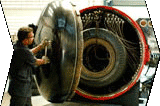Process Retreading

1. Inspection
Determine if a worn tyre casing can be accepted for retreading or rejected.

2. Buffing
Remove the worn tyre tread from the casing.

3. Skiving
Remove any embedded objects to ensure a clean and solid surface suitable for retreading.

4. Cementing
Spraying of a thin layer of concentrated rubber solution onto the repaired casing.

5. Filling
Filling of the skived area with gum cord.

6. Tread
Application A cushion gum bonding layer is placed between the tread and the casing. New layer of highly compact precured tread is then built onto the casing.

7. Enveloping
Special envelop is used to enclose the tyre and ensure the casing, bonding gum and precured tread are successfully bonded together.

8. Curing
Special envelop is used to enclose the tyre and ensure the casing, bonding gum and precured tread are successfully bonded together.

9. Final Inspection
All retreaded tyres are closely inspected to ensure that a safe and attractive product will be recycled to the customers.

10. As good as new!
Just like a brand new tyre, now the retreaded tyre is ready to roll on the road!
When tyres become worn, they can be restored with new tread. According to the Tyre Retread Information Bureau, USA, there is no significant difference in quality between new and retreaded tyres. Many tyres can be repeatedly retreaded, delaying the landfill disposal of the tyres and enhancing our environment through recycling. Large truck tyres are typically retreaded as part of a routine tyre- management program.
Two reasons are cited for this preference. First, the low cost to retread tyres makes it a cost effective routine measure for modern tyre-management program. Second, precure retread tyres are perceived to have higher mileage return than new tyres. This means better cost savings for the wise fleet managers. This is especially true on specialty wheels that are costly to replace. Newera Equipment’s retreading system is able to provide retreaders with effective inspection of tyres, buffing, repairing, building new treads and curing.
Two reasons are cited for this preference. First, the low cost to retread tyres makes it a cost effective routine measure for modern tyre-management program. Second, precure retread tyres are perceived to have higher mileage return than new tyres. This means better cost savings for the wise fleet managers. This is especially true on specialty wheels that are costly to replace. Newera Equipment’s retreading system is able to provide retreaders with effective inspection of tyres, buffing, repairing, building new treads and curing.

1. Inspection
Determine if a worn tyre casing can be accepted for retreading or rejected.

2. Buffing
Remove the worn tyre tread from the casing.

3. Skiving
Remove any embedded objects to ensure a clean and solid surface suitable for retreading.

4. Cementing
Spraying of a thin layer of concentrated rubber solution onto the repaired casing.

5. Filling
Filling of the skived area with gum cord.

6. Tread
Application A cushion gum bonding layer is placed between the tread and the casing. New layer of highly compact precured tread is then built onto the casing.

7. Enveloping
Special envelop is used to enclose the tyre and ensure the casing, bonding gum and precured tread are successfully bonded together.

8. Curing
Special envelop is used to enclose the tyre and ensure the casing, bonding gum and precured tread are successfully bonded together.

9. Final Inspection
All retreaded tyres are closely inspected to ensure that a safe and attractive product will be recycled to the customers.

10. As good as new!
Just like a brand new tyre, now the retreaded tyre is ready to roll on the road!

